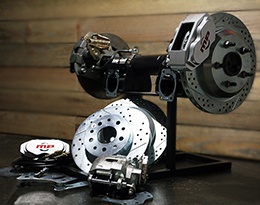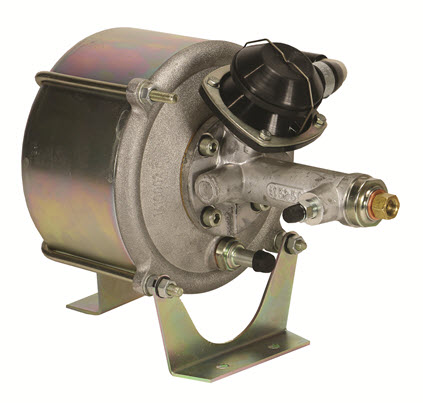We’re going to dive into the details of single versus dual diaphragm power boosters: what they are, size and performance specs, what function they play, how they enhance your ride, and how to decide which you need for your vehicle and why.
Before that, we’ll give you a quick overview of a braking system and the role of the brake booster.
Braking System Overview
Both disc and drum brakes work by displacing the energy of motion in the form of heat in order to stop your vehicle. Most modern vehicles have either a combination of disc brakes in the front and drum brakes in the rear or a disc brake system on all four wheels. Older vehicles may still have an all-drum brake system.

Disc brakes are more efficient at displacing heat and, therefore, stop your vehicle much more efficiently than drum brakes. Since most of the braking needs to occur in the front of the vehicle to stop forward momentum, disc brakes are the preferred choice for front brakes.
The act of braking begins when you depress the brake pedal and the master cylinder uses that pressure to push a piston, which sends hydraulic fluid through the brake lines to each individual brake. Pistons inside of a bore that are located on each of the four brakes, fill with brake fluid and engage the pads or shoes and squeeze against the rotor or brake drum and stop your vehicle.
What are Brake Boosters?
Now, let’s discuss manual and power brakes. What differentiates these two types is simple: power brakes offer power assistance to the pedal, while manual brakes offer none. This is why brake boosters are often referred to as power boosters. The brake hardware at the wheels will be identical whether you have all disc, disc/drum combo, or all drum brakes. Power brakes are simply brakes that have a power booster installed to assist with ease of braking, requiring less physical force.

So, how do they work?
A power brake booster is installed and connected directly to the brake pedal. When you press the pedal, that movement allows the diaphragms to pull in air from the atmosphere which already has a vacuum being pulled on them from the engine or some other vacuum source. This allows the pushrod internally to press against the back of the master cylinder and therefore generate pressure through the master cylinder and brake lines. This allows the brakes to engage and the vehicle to stop with less physical exertion and pressure force from the driver.
Single vs. Dual Diaphragm Power Boosters
Whether you choose a single or dual diaphragm booster depends on how much brake assistance your vehicle needs. A dual diaphragm offers the most assistance, and is ideal on an all-disc system or a disc-drum combination. If you want to keep your vehicle’s four-wheel drum system, then a single diaphragm booster would be ideal. In this instance, too much of a brake assist would make your brakes too touchy and send you lurching forward every time you engage the brakes.
Booster Size
Power booster size can range from 7” up to 11” in both single and dual diaphragm types. Your booster size choice is often determined by how much room is available inside the vehicle, as determined by hood clearance, valve cover, and engine block size.
How to Choose the Right Power Booster
When in doubt, go with the largest diameter size that will comfortably fit your vehicle. Larger diameters and dual diaphragms generally offer more assistance.
With disc brake conversions, we recommend going with a dual diaphragm and as much diameter size as will fit the space.
With all-drum systems, you can’t go wrong with either a single diaphragm booster or a small-diameter dual diaphragm booster to give you the right amount of assistance without making it uncomfortably touchy.
Power boosters simply make driving your car easier and more enjoyable. Remember, when it comes to selecting a power booster for your vehicle, consider your brake type setup and the size of space available in your car. Always go with the maximum amount of booster that will comfortably fit.
Unfortunately, there isn’t a guide or formula to easily determine which booster to choose. If you’re still stumped, drop us a line and we’ll gladly walk you through the steps to determine what is best for your application.
